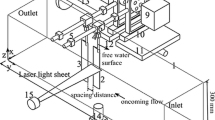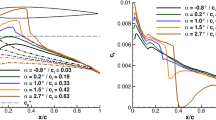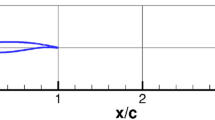Abstract
Experiments were performed to investigate the aerodynamic characteristics of two-wing configurations at a low Reynolds number of 100,000. The wing models were rectangular flat plates with a semi-aspect ratio of two. The stagger between the wings was varied from ∆X/c = 0 to 1.5; the gap was varied from ∆Y/c = 0 to 2 and ∆Y/c = −1.5 to 1.5 for biplane and tandem configurations, respectively, with the decalage angle fixed at 0°. Lift, drag, aerodynamic efficiency and power efficiency ratios show that for small incidence angles, performance compared with the single wing is degraded. However, for single-wing post-stall angles of attack, lift performance improves and stall is delayed significantly for many configurations with nonzero gap, i.e., ∆Y/c ≥ 0. For a fixed angle of attack, there are optimal gaps between the wings for which total lift becomes maximum. Particle image velocimetry measurements show that performance improvement relies heavily on the strength of the inter-wing flow and the interaction of the separated shear layers from the leading edge and trailing edge of the leading wing with the trailing wing. Unsteady forces are found to intensify for certain two-wing configurations. A switching between the stalled and unstalled states for the trailing wing as well as a switching between the merged and distinct wakes is shown to have high flow unsteadiness and large lift fluctuations.






















Similar content being viewed by others
Abbreviations
- b :
-
Semi-span
- c :
-
Chord length
- C D :
-
Time-averaged drag coefficient
- C D1 :
-
Time-averaged drag coefficient of wing 1
- C D2 :
-
Time-averaged drag coefficient of wing 2
- C Dm :
-
Time-averaged monoplane drag coefficient
- C Dt :
-
Time-averaged total drag coefficient, (C D1 + C D2)/2
- C L :
-
Time-averaged lift coefficient
- C L1 :
-
Time-averaged lift coefficient of wing 1
- C L2 :
-
Time-averaged lift coefficient of wing 2
- C Lm :
-
Time-averaged monoplane lift coefficient
- C Lt :
-
Time-averaged total lift coefficient, (C L1 + C L2)/2
- q :
-
Dynamic pressure
- R AE :
-
Time-averaged aerodynamic efficiency ratio, (C Lt /C Dt)/(C Lm /C Dm)
- R D :
-
Time-averaged drag ratio, C Dt /C Dm
- Re :
-
Reynolds number, ρU ∞ c/μ
- R L :
-
Time-averaged lift ratio, C Lt /C Lm
- R PE :
-
Time-averaged power efficiency ratio, (C 3/2Lt /C Dt)/(C 3/2Lm /C Dm)
- sAR:
-
Semi-aspect ratio
- U′:
-
Streamwise velocity component
- u′ :
-
Standard deviation of streamwise velocity
- U ∞ :
-
Freestream velocity
- V :
-
Crosswise velocity component
- v′:
-
Standard deviation of crosswise velocity
- X :
-
Streamwise/longitudinal coordinate
- Y :
-
Crosswise/transverse coordinate
- Z :
-
Spanwise coordinate
- α :
-
Angle of attack
- δ :
-
Decalage
- ∆X/c :
-
Stagger between the wings
- ∆Y/c :
-
Gap between the wings
- μ :
-
Viscosity
- ρ :
-
Density
- σ CLm :
-
Standard deviation of lift coefficient for monoplane wing
- σ CL1 :
-
Standard deviation of lift coefficient for wing 1
- σ CL2 :
-
Standard deviation of lift coefficient for wing 2
- ω:
-
Vorticity
References
Carmichael B (1981) Low Reynolds number airfoil survey. vol 1. NASA CR 165803, Hampton, VA
Cleaver DJ, Wang Z, Gursul I, Visbal M (2011) Lift enhancement by means of small-amplitude airfoil oscillations at low Reynolds numbers. AIAA J 49:2018–2033. doi:10.2514/1.J051014
Davis WR, Kosicki BB, Boroson DM, Kostishack DF (1996) Micro air vehicles for optical surveillance. Linc Lab J 9:197–214
Frampton KD, Goldfarb M, Monopoli D, Cveticanin D (2001) Passive aeroelastic tailoring for optimal flapping wings. In: Mueller TJ (ed) Fixed and flapping wing aerodynamics for micro air vehicle applications. Progress in Astronautics and Aeronautics, AIAA, Reston, pp 473–482
Glauert H (1959) Elements of aerofoil and airscrew theory. Cambridge University Press, Cambridge
Jones R, Cleaver DJ, Gursul I (2015) Fluid-structure interactions for flexible and rigid tandem-wings at low Reynolds numbers. 53rd AIAA Aerospace Sciences Meeting, Kissimmee, FL, AIAA Paper-2015-1752
Knight M, Noyes R (1929a) Wind tunnel pressure distribution tests on a series of biplane wing models part I : effects of changes in stagger and gap. NACA TN 310
Knight M, Noyes R (1929b) Wind tunnel pressure distribution tests on a series of biplane wing models part II : effects of changes in decalage, dihedral, sweepback and overhang. NACA TN 325
Knight M, Noyes R (1929c) Wind tunnel pressure distribution tests on a series of biplane wing models part III : effect of changes in various combinations of stagger, gap, sweepback and decalage. NACA TN 330
Moffat RJ (1985) Using uncertainty analysis in the planning of an experiment. J Fluid Eng 107:173–178. doi:10.1115/1.3242452
Moschetta J-M, Thipyopas C (2007) Aerodynamic performance of a biplane micro air vehicle. J Aircr 44:291–299. doi:10.2514/1.23286
Mueller TJ (2000) Aerodynamic measurements at low Reynolds numbers for fixed wing micro-air vehicles. RTO AVT/VKI, Special Course on Development and Operation of UAVs for Military and Civil Applications, von Karman Institute, September, RTO-EN-9, ISBN 92-837-1033-9
Mueller T, DeLaurier JD (2001) An overview of micro air vehicle aerodynamics. In: Mueller TJ (ed) Fixed and flapping wing aerodynamics for micro air vehicle applications. Progress in Astronautics and Aeronautics, AIAA, Reston, pp 1–10
Mueller TJ, DeLaurier JD (2003) Aerodynamics of small vehicles. Annu Rev Fluid Mech 35:89–111. doi:10.1146/annurev.fluid.35.101101.161102
Null W, Shkarayev S (2005) Effect of camber on the aerodynamics of adaptive-wing micro air vehicles. J Aircr 42:1537–1542
Olson EC, Selberg B (1976) Experimental determination of improved aerodynamic characteristics utilizing biplane wing configurations. J Aircr 13:256–261. doi:10.2514/3.44523
Pelletier A, Mueller TJ (2000) Low Reynolds number aerodynamics of low-aspect-ratio, thin/flat/cambered-plate wings. J Aircr 37:825–832. doi:10.2514/2.2676
Prandtl L, Tietjens O (1957) Applied hydro-and aeromechanics. Dover Publications, Inc., Dover, pp 211–212
Scharpf DF, Mueller TJ (1992) Experimental study of a low Reynolds number tandem airfoil configuration. J Aircr 29:231–236. doi:10.2514/3.46149
Selig MS, Donovan JF, Fraser DB (1989) Airfoils at low speeds. H.A. Stokely, Virginia Beach
Torres G, Mueller TJ (2000) Micro aerial vehicle development: design, components, fabrication, and flight-testing. In: AUVSI Unmanned Systems 2000 Symposium and Exhibition, pp. 11–13
Traub LW (2001) Theoretical and experimental investigation of biplane delta wings. J Aircr 38:536–546. doi:10.2514/2.2794
Wang Z, Gursul I (2012) Unsteady characteristics of inlet vortices. Exp Fluids 53:1015–1032. doi:10.1007/s00348-012-1340-2
Zaman K, McKinzie D, Rumsey C (1989) A natural low-frequency oscillation of the flow over an airfoil near stalling conditions. J Fluid Mech 202:403–442. doi:10.1017/S0022112089001230
Acknowledgments
This work was supported by the University of Bath University Research Scholarship. The authors would also like to acknowledge the University of Bath’s technical staff for their continued support. The authors also thank the EPSRC Engineering Instrument Pool.
Author information
Authors and Affiliations
Corresponding author
Rights and permissions
About this article
Cite this article
Jones, R., Cleaver, D.J. & Gursul, I. Aerodynamics of biplane and tandem wings at low Reynolds numbers. Exp Fluids 56, 124 (2015). https://doi.org/10.1007/s00348-015-1998-3
Received:
Revised:
Accepted:
Published:
DOI: https://doi.org/10.1007/s00348-015-1998-3




